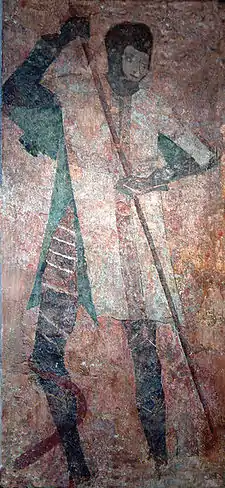Thomas Hungerford of Rowden
Sir Thomas Hungerford of Rowden (died 17 January 1469), the eldest son of Robert Hungerford, 3rd Baron Hungerford, lived chiefly at Rowden, near Chippenham, Wiltshire. After giving some support to Edward IV and the Yorkists he joined in Warwick's conspiracy to restore Henry VI in January 1469, was attained, and was executed at Salisbury, Wiltshire. He was buried in the chapel of Farleigh Castle.[1]

He was pardoned for participating in the rebellion of his father in November 1462 and was knighted not long afterward. He was allowed to inherit some of his attained father's lands.[2] After joining Warwick's rebellion he was arrested with Henry Courtenay (brother of Thomas Courtenay, 6th/14th Earl of Devon) in Wiltshire before 11 November 1468. They were tried on 12 January 1469 in Salisbury before a court headed by six peers including Richard, Duke of Gloucester and found guilty by a jury of 16. They were charged with having plotted with Margaret of Anjou on 21 May 1468 and other occasions the "final death and final destruction...of the Most Christian Prince, Edward IV."[3] They were executed in the presence of the king and received the "fullest and protracted horrors" of a fifteenth century execution.[4]
Sir Thomas married (before 16 October 1460) Anne, daughter of Henry Percy, 2nd Earl of Northumberland, who married two husbands after his death—Sir Lawrence Raynesford and Sir Hugh Vaughan—and, dying on 5 July 1522, was buried in St. Margaret's Church, Westminster.[1]
Sir Thomas left by Anne an only child, Mary, 4th Baroness Hungerford, who became the ward of William, Lord Hastings, and in 1480 married Sir Edward (afterwards Lord) Hastings, her guardian's son. The attainders on her father and grandfather were reversed in her favour in 1485, and her husband was summoned to Parliament as Lord Hungerford. George Hastings, 1st Earl of Huntingdon, was her son.[1]
Notes
- Lee, Volume 28, p. 257
- Ross, Charles (1974). Edward IV. Berkeley and Los Angeles, Calif.: University of California Press. p. 66. ISBN 0-520-02781-7.
- Ross, pgs. 122-123
- Ross, pgs. 66, 123
References
- Lee, Sidney Dictionary of National Biography (1885–1900) Volume 28, p. 257
- Dugdale's Baronage;
- Hoare's Hungerfordiana;
- Letters, &c., of Henry VIII;
- Materials for the Reign of Henry VII (Rolls Ser.);
- Paston Letters, passim, ed. Gairdner
- Hoare's Modern Wiltshire, Heytesbury Hundred
- Collinson's Somerset, iii. 355
- Attribibution
- Lee, Sidney, ed. (1891). . Dictionary of National Biography. 28. London: Smith, Elder & Co.